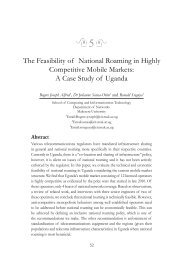Undergraduate Handbook - School of Computing and Informatics ...
Undergraduate Handbook - School of Computing and Informatics ...
Undergraduate Handbook - School of Computing and Informatics ...
You also want an ePaper? Increase the reach of your titles
YUMPU automatically turns print PDFs into web optimized ePapers that Google loves.
Reference Books:<br />
i. H. G-Molina, J. D. Ullman, <strong>and</strong> J. Widom, Database Systems: The Complete Book, Prentice Hall. 2002.<br />
ii. R. Elmasri <strong>and</strong> S. B. Navathe, Fundamentals <strong>of</strong> Database Systems, 4th edition.<br />
BSE 2104: Computer Architecture (3 CU)<br />
Course Description: Upon successful completion <strong>of</strong> the course, the student should: Have gained an underst<strong>and</strong>ing<br />
<strong>of</strong> basic components <strong>of</strong> the modern computer system; Be able to describe the operation <strong>of</strong> the various logic gets; Be<br />
able to design digital circuits; Demonstrate a good underst<strong>and</strong>ing <strong>of</strong> sequential <strong>and</strong> parallel processing; Perform low<br />
level assembly programming; <strong>and</strong> perform low level memory management.<br />
Indicative Content: Computer Organization <strong>and</strong> Structures (based on the Von Neumann architecture); Processor<br />
unit organization: control unit, ALU, processor register <strong>and</strong> internal buses; hardwired <strong>and</strong> micro-programmed<br />
control. Instructions sets, formats <strong>and</strong> types; Addressing modes, stacks, pipelining, RISC/CISC concepts; Memory<br />
organization <strong>and</strong> addressing; Memory hierarchy <strong>and</strong> cache; Special-purpose co-processors; I/O facilities <strong>and</strong> storage<br />
devices; The Operating System level.<br />
Reference Books:<br />
i. D. A. Patterson <strong>and</strong> J. L. Hennessy, Computer Architectures: A Quantitative Approach, Morgan Kaufmann<br />
Publishers, 3rd edition, 2003.<br />
ii. A. S. Tanenbaum, Structured Computer Organisation, 4th edition, Prentice Hall inc., Upper Saddle River,<br />
1999.<br />
BSE 2200: Systems S<strong>of</strong>tware (4 CU)<br />
Course Description: By the end <strong>of</strong> this course, Students will underst<strong>and</strong> the various levels <strong>of</strong> system <strong>and</strong><br />
application s<strong>of</strong>tware; They will be familiar with the major Operating System services such as file systems, memory<br />
management, process management, device control <strong>and</strong> network services; They will underst<strong>and</strong> how design decisions<br />
in Operating Systems affect users <strong>of</strong> the system; In addition, students will have used a major Operating System<br />
extensively, with experience in using an interactive comm<strong>and</strong> line programming language; <strong>and</strong> They will also will<br />
have experience in using a systems programming language with an Application Programmers Interface to the<br />
Operating System for its services based on Unix OS, <strong>and</strong> the C systems programming language.<br />
Indicative Content: This course looks at the necessary system architecture introduction for further study <strong>of</strong><br />
operating systems, computer architectures, <strong>and</strong> the implementation <strong>of</strong> higher level languages. It goes further <strong>and</strong><br />
builds upon that by looking at the concepts underlying Operating Systems, <strong>and</strong> to show how different choices in<br />
Operating System design <strong>and</strong> implementation have effects on applications, application programmers <strong>and</strong> user<br />
environments.<br />
Reference Books:<br />
i. L. L. Beck, System S<strong>of</strong>tware: An Introduction to Systems Programming, Addison Wesley; 3rd edition,<br />
August, 1996.<br />
ii. A. S. Tanenbaum, Modern Operating Systems, 2nd edition, Prentice Hall 2001.<br />
iii. A. Silberschatz, P. B. Galvin <strong>and</strong> G. Gagne, Operating Systems Concepts, 6th edition, John Wiley & Sons<br />
2002.<br />
BSE 2201 Network Application Development (4 CU)<br />
Course Description: This course is designed to: Familiarize students with technologies <strong>and</strong> protocols that support<br />
computer communication networks, including the Internet; <strong>and</strong> elaborate on network based programming<br />
methodologies, languages, tools <strong>and</strong> st<strong>and</strong>ards.<br />
Indicative Content: Design principles for network-based applications; design <strong>and</strong> development <strong>of</strong> Java Servlets,<br />
JSP, Web services <strong>and</strong> .NET; principles <strong>of</strong> information security in network-based applications; http <strong>and</strong> https<br />
protocols.<br />
112

















